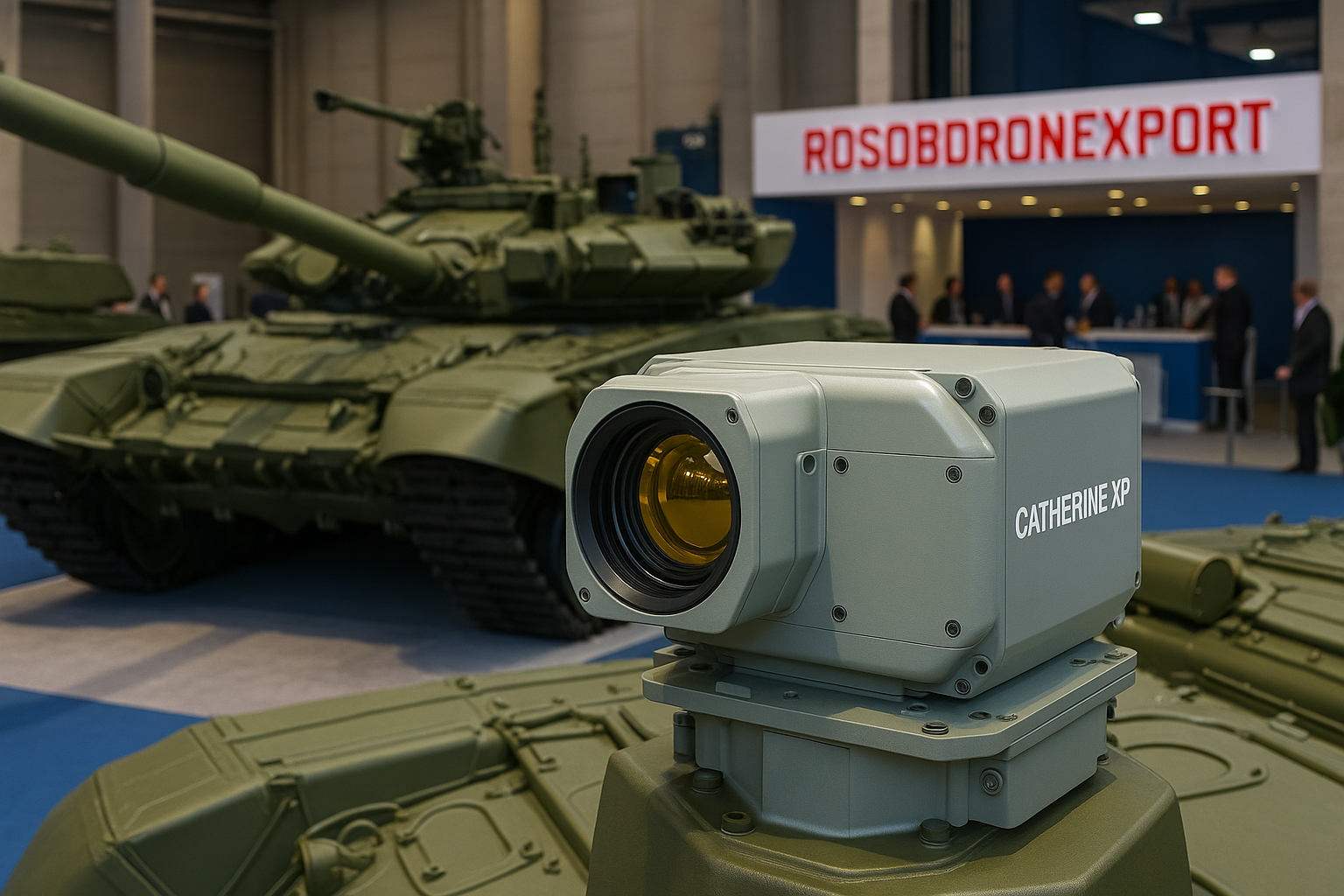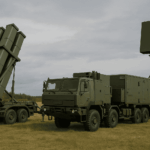Paris—At Eurosatory 2012 Russia’s state arms trader Rosoboronexport and France’s Thales Optronics signed a licence that lets the Vologda Optical-Mechanical Plant build Catherine XP thermal imagers inside Russia. A second document covers factory-level repairs of all Thales units already in Russian service. The deal marks the first time a Western third-generation seeker will roll off a Russian line.
French Thermal Imagers Enter Russian Service via Local Assembly
Serge Adrian, head of Thales Optronics, and Igor Sevastyanov, deputy director general of Rosoboronexport, penned the paperwork in front of Deputy Prime Minister Dmitry Rogozin and Russian Technologies executive Dmitry Shugayev. Kremlin officials framed the accord as a fast way to plug a long-acknowledged night-sight gap without waiting years for a clean-sheet domestic design.
The Catherine XP replaces the older Catherine FC that Russia imported in batches of roughly 100 cameras starting in 2007. Field units reported dependable performance but wanted lighter weight and longer reach. The XP answers that call. Its sensor chases targets beyond ten kilometres while trimming power draw by almost one-third. The Catherine family shares design lineage with Sagem’s Euroflir 350, a system recently chosen for French special forces helicopters.
Specs of Catherine XP for Tank Thermal Sight Applications
- 3 kg assembly versus 5.5 kg for the FC
- 640 × 512 QWIP matrix, up from 288-row scanning array
- Detection range: infantry 6 km, armour 11 km, aircraft 18 km
- Warm-up under three minutes; continuous run six hours
- Rugged electronics qualified from –40 °C to +55 °C
Vologda’s plant already hosts a Catherine FC service hub opened in 2008. The license extends that work into full manufacture. Thales will ship starter kits—uncooled cores, cryo coolers, and germanium optics—while Russian staff master each step. A shared engineering cell in Vologda will handle process audits and quality checks.
Vehicle-Mounted Thermal Camera Line Boosts Russian Armor Upgrades
Rosoboronexport says the first locally finished cameras go to the Land Forces for the Sosna-U gunner’s sight used on T-72B3 and T-90 tanks. Export customers can order the same fit once French authorities clear each case. Paris insisted on a “no rogue state” clause that blocks onward sales to embargoed buyers such as Iran or North Korea.
Deputy Prime Minister Rogozin hailed the move as proof that Russia can “close a twenty-year lag in one stroke”. Yet Moscow also signalled caution. Officials stressed that French optics are a bridge, not a destination, and pledged parallel funding for Shvabe and Krasnogorsk plants to mature a fully home-grown sensor by the end of the decade.
The Catherine line grew out of earlier joint work. In 2009 Rosoboronexport secured a licence for FC assembly. Feedback from field trials in Chechnya and the Far East shaped the XP’s final spec, especially its wider field-of-view option for urban combat.
Programme planners expect:
- Nine months to finish tooling and staff training
- First qualification test shots by spring 2013
- Annual output stabilising at 2,000 modules by 2015
- Break-even after 4,600 units, factoring export prospects and life-cycle support
The Vologda region counts on 350 new jobs plus orders for local glass suppliers. Thales, for its part, gains a steady royalty stream and a foothold in Russia’s vast armoured-vehicle recapitalisation drive.
Igor Sevastyanov underlined that every XP leaving Vologda will carry a Russian serial and fall under domestic quality law. That stipulation reassures the Defence Ministry, which ran into warranty disputes when earlier foreign electronics failed outside home country repair chains.
Applications Beyond Tank Optics
Engineers are already mapping the XP onto other sights. Candidates include the Shooter-1 remote weapon station, the Arena-E active-protection radar cue, and the new Khrizantema anti-tank missile launcher. Each integration opens fresh export lanes where night-fighting ability often decides competitions.
Beyond ground systems, Rosoboronexport is studying a gimbal-stabilised pod for rotary-wing search-and-rescue. Early bench tests mate the XP core with a 10× optical zoom and laser pointer, yielding a 15 kg package palatable for Mi-8 upgrades.
French observers see mutual benefit. Thales gains volume that helps amortise its QWIP line, while Rosoboronexport gets a NATO-proven sensor to shore up credibility in tenders across Asia and the Middle East. Shareholders on both sides expect the deal to survive routine political squalls given its commercial logic and modest strategic sensitivity.
Russia’s broader optics sector remains patchy. Domestic micro-bolometers still trail French and Israeli designs. The licence thus plugs a near-term gap while R&D teams chase a cleaner-sheet 12-micron pitch detector. In the interim, Moscow banks on stable Franco-Russian ties to keep hardware flowing.
Tank Thermal Sight Production Adapts Under Sanctions – MARCH 2025 UPDATE
Thirteen years on, the partnership tells a different story. EU sanctions imposed after Crimea in 2014 froze direct deliveries of critical XP sub-assemblies. Thales honoured standing warranty commitments but stopped fresh transfers in mid-2015. Russian crews therefore drew on a finite stock of imported coolers and chips while Vologda engineers raced to redesign the camera around locally sourced parts.
Stopgap measures kept tanks rolling, yet output never hit the planned 2,000-unit rhythm. By 2018 Shvabe unveiled the Irbis-K sight with an MCT detector built at the Central Research Institute “Cyclone”. Field tests on the T-80BVM showed promise, though image grain rose under high humidity. Crews still favoured the smoother Thales picture when spares were available.
Captured T-90Ms in Ukraine in 2023 confirmed that many gunner sights still housed French-labelled matrices dated as late as 2016. Their presence fuelled political heat in Paris, triggering an audit of pre-sanction licence waivers and end-user logs. The Elysee said all shipments conformed to EU law at the time but conceded that retrofit kits may have slipped through re-export loopholes.
Russian industry meanwhile leaned on parallel-import networks. Customs data reviewed by The Insider shows thermal-imaging parts worth over $50 million reached Russia in 2024 via Dubai, Hong Kong, and Yerevan. Many items match XP spares, including Stirling coolers and germanium blanks.
Moscow brands this trade legal, citing dual-use codes, but Brussels tightened controls in February 2024 with Decision 2024/746, blacklisting six Emirati and Armenian brokers. Washington followed by expanding its SDN list and threatening secondary penalties on any bank clearing optical components above €1,000 per unit.
Vologda’s shop floor adjusted again. Engineers swapped imported coolers for a cryo-free module built by NPO Orion. Early batches entered pilot lots of the Sosna-U-M sight in late 2024. Soldiers report shorter detection range—about eight kilometres against armour—but praise the simpler maintenance routine.
Future Russian Tank Optics Aim for Independence by 2027
Looking ahead, Rostec plans a 1280 × 1024 detector line at the Kaluga plant tied to its Photon programme. If the line reaches yield, the Defence Ministry will phase out XP kits entirely by 2027. Until then, commanders juggle inventories: French-rooted optics on frontline T-90Ms, Irbis-K on T-80BVMs, and a patchwork of domestic trial cameras elsewhere.The story that began as a model of East-West tech sharing now illustrates the rough edge of sanctions warfare. What remains from the original contract are the production jigs, trained workers, and a decade of know-how—assets Russia hopes will outlive embargo turbulence. Engineers in Vologda insist that Russia “will never again build a tank blind at night,” though the sensor family guiding that claim is no longer French. Much like other dual-use equipment with foreign origins, the technology behind these systems may be not so Russian after all.
REFERENCE SOURCES
- https://euromaidanpress.com/2025/05/21/frontelligence-insight-leaked-files-reveal-russias-defense-optics-house-of-cards-under-strain-of-war-and-sanctions/
- http://www.spsmai.com/military/?id=1465&q=Russia-to-produce-French-new-generation-thermal-imagers
- http://www.deagel.com/news/n000010416
- http://www.strategypage.com/htmw/htproc/articles/20120623.aspx
- http://xn--80aaccfg6bffxbbd3bgq4owb.xn--p1ai/en/newsflash/france_hands_over_night_vision_technology_to_russia/
- https://www.army-guide.com/eng/article/article_789.html
- https://ru.wikipedia.org/wiki/Катрин-ФС
- https://bulgarianmilitary.com/2023/10/06/t-90ms-thermal-camera-matrix-is-russian-made-under-french-license/
- https://theins.ru/en/news/278968
- https://2021-2025.state.gov/new-measures-targeting-third-country-enablers-supporting-russias-military-industrial-base/
- https://eur-lex.europa.eu/legal-content/EN/TXT/PDF/?uri=OJ:L_202400746



